Below is the view to
the southeast when I checked out this site in
2019 with a rotatable dipole and 100w.
Horizon is under 5 degrees elevation from 45
degrees azimuth around through south to 340
degrees, providing a clear shot at the entire
continental US plus KH6 and KL7. As you can see
in the above profile, much of the horizon is
below 0 degrees.
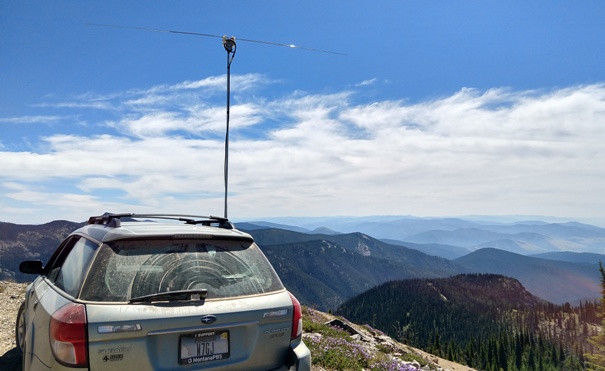
|
For the tail end of the Perseids
meteor shower on August 13, 2020, I went up
again to activate DN37aa for people within
meteor scatter range who still needed that grid.
It took me 5 hours to drive up there and get set
up, but I was able to operate MSK144 on 6m for 6
hours before I had to tear down. I did manage to
work 22 stations, even though the afternoon is
not an ideal time to work meteor scatter.
The setup is shown below. I used 1kw
output from my 6M1K2 amplifier, 50' of LMR600UF
feedline to my 6M5XHG yagi up on a 24' high
mast. As you can see from the photo and the
horizon profile above, the antenna was at the
edge of an extremely sharp cliff, and the
horizon many directions was below 1 or even 0
degrees elevation. All contacts were uploaded to
LOTW.
|
|
|
|
June 13-14,
2020
DN37uc at
6525' on Sunset Mountain
|
Horizon
Profile from DN37tc site

|
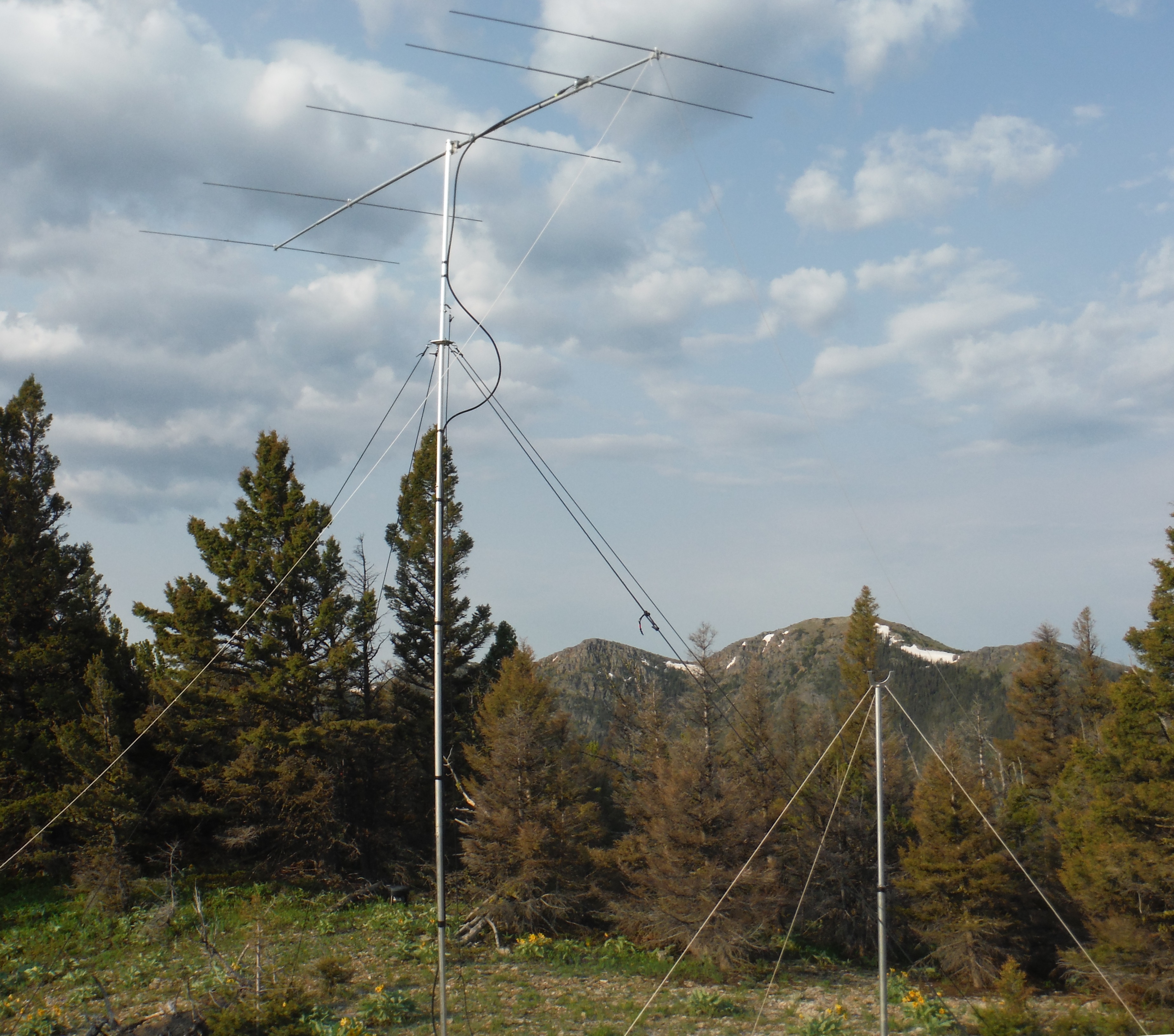
6M5XHG installed on top
of Sunset Mountain
|
The highest point on the horizon
is 3.3 degrees elevation toward central
California. As you can see from the above
profile, much of the horizon is below 0 degrees.
The plan was to activate it this year with a kw
and 6M5XHG during the ARRL June VHF Contest.
Unfortunately, the amp failed at the start of
the contest, and bad weather coming in forced a
hasty teardown and retreat on Saturday afternoon
June 13.
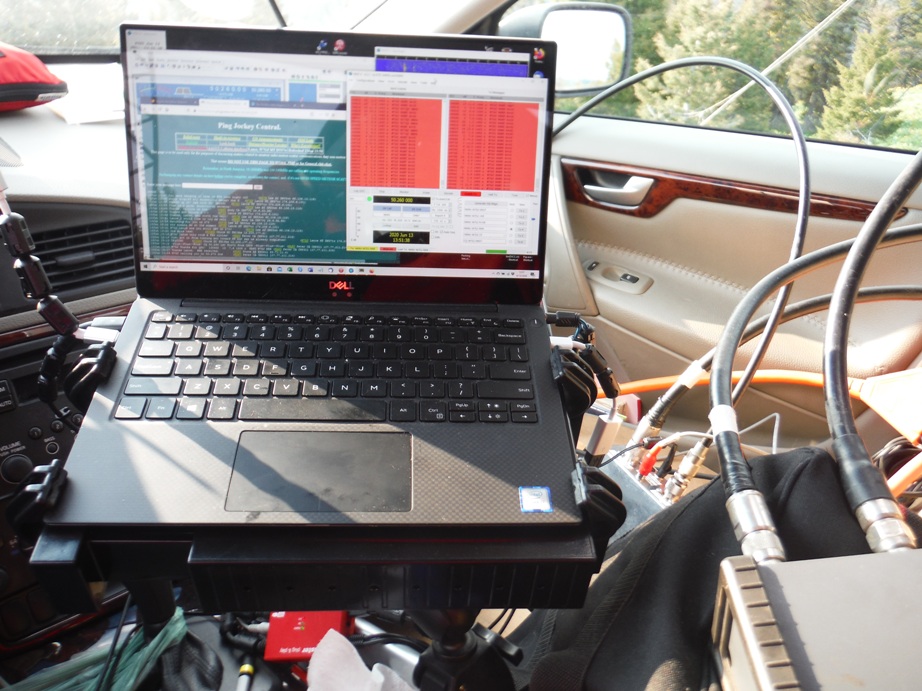 Working MSK144 meteor scatter from the
front seat of the car on June 13
Working MSK144 meteor scatter from the
front seat of the car on June 13
|
|
|
June 19-22,
2020
Confluence of
DN55xx, DN56xa, DN65ax, and DN66aa at 46º N
and 108º W, at an elevation of 3005' ASL
|
Horizon Profile from the
Confluence of DN55, DN56, DN65 and DN66

As you can see from the above
profile, the highest point on the horizon is
below 2.3 degrees elevation, and that is
toward KL7. Most of the rest of the horizon is
below 1 degree elevation. KB7Q and I
were both 6m operators on this activation,
although we used my call for all the 6m
operation. KB7Q's 2m activity is described HERE. |

THE OPERATION
There were a number of stations who still needed
one of more of these four grids for the FFMA and
6m, so I decided to investigate the feasibility
of operating from the "confluence" (where all
four grids meet). I identified the rancher
who owned the property and began a dialogue with
him at the end of 2019. Terms were agreed
to, liability releases sent to him, and he
agreed to let KB7Q and I operate there for a few
prime days around the Summer Solstice. KB7Q
operated 2m meteor scatter from DN65 and the
DN56/66 line, and helped me pull off the 6m
operation from the actual confluence.
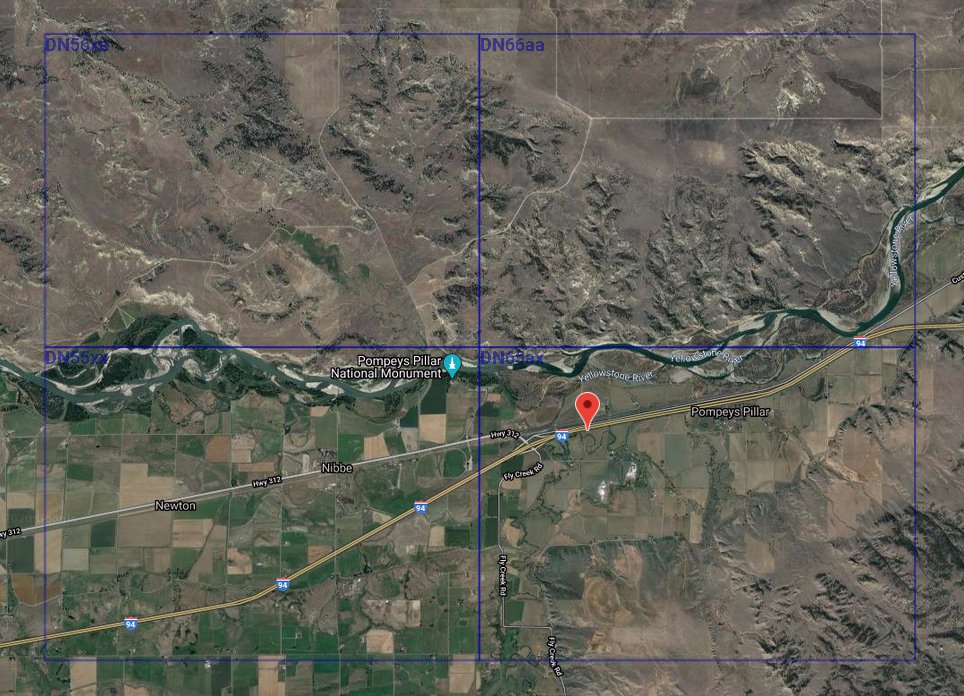
I drove to KB7Q's QTH in Bozeman on Thursday
June 18, On Friday June 19, we set out for
the Confluence, and arrived on the site around
11 am MDT. We spent the rest of the day
setting up the operating tent, assembling and
raising the antenna, unpacking and setting up
the equipment. Saturday morning June 20, I began
making 6m meteor scatter contacts before 6 am
(1200 Z). When the MSK144 contacts turned to Es,
I switched to FT8. Most of the Es was single
hop. Because of the higher ground immediately to
the northwest, most of the contacts into the
Pacific Northwest were made by using Es
backscatter while I was aiming toward the
southeast.
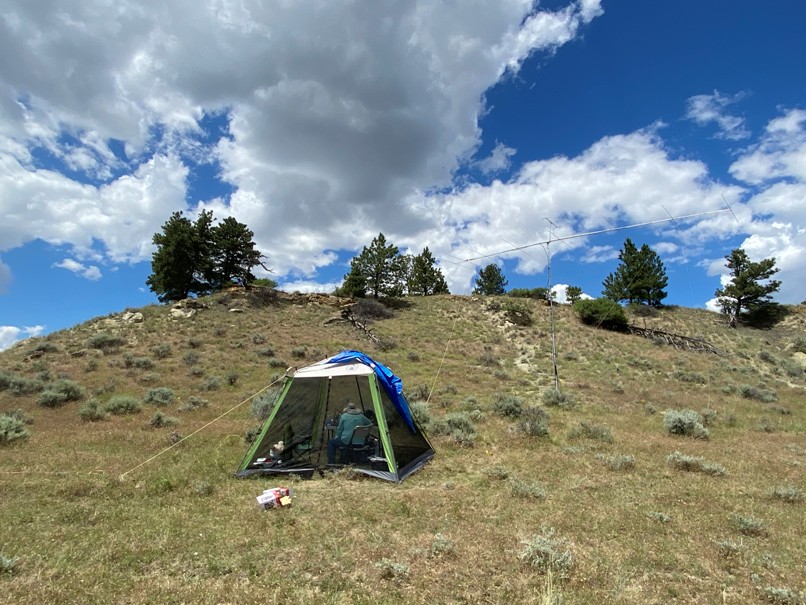
Sunday, rain came and went several times,
requiring the equipment and operator to be
covered. However, we were able to continue
operating until the band faded out Sunday night,
with double hop down to southern Mexico.
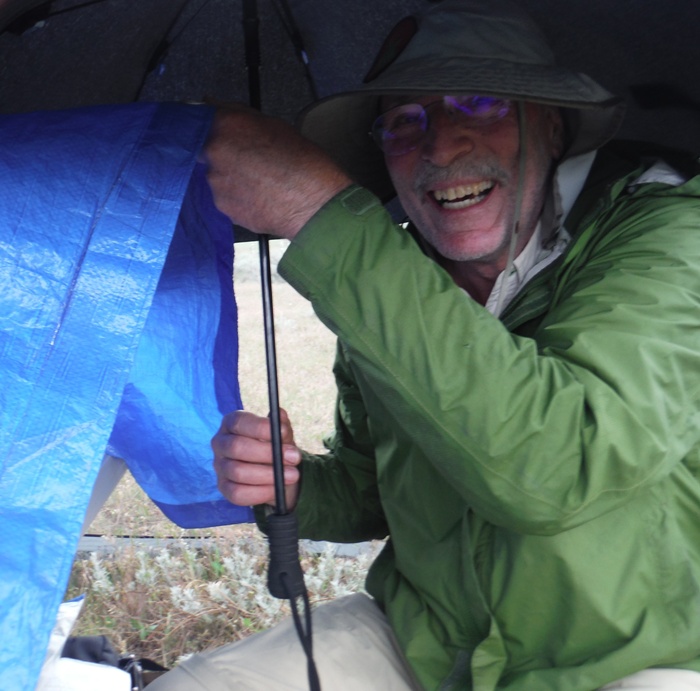
W7GJ under an umbrella in
the operating tent
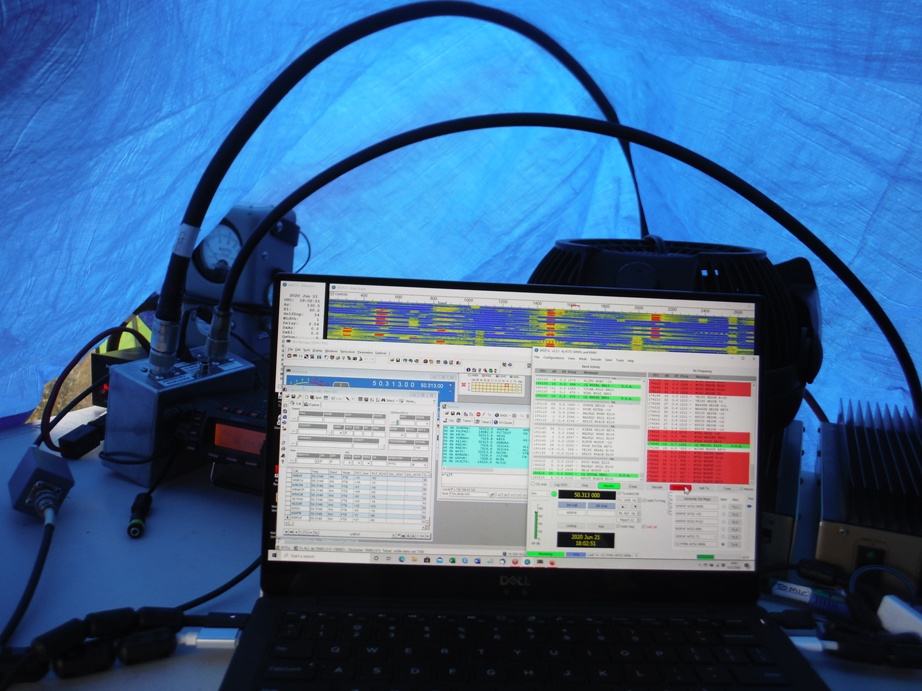
Working FT8 mode during
the rainstorms
A huge thunderstorm passed over on Sunday night,
with very close lightning and heavy rain.
Fortunately, the equipment was safely covered
under the tarp and the only problem on Monday
morning was the re-infused mud ("gumbo") that
stuck to everything. During the early
morning meteor scatter session on Monday, I
remembered that I DID have elevation on the
yagi, and in fact WSJT-X was suggesting that I
needed to elevate if I wanted to work the short
meteor scatter (around 500 miles) to the Pacific
Northwest. So, I elevated and was able to
work a number of west coast stations on meteor
scatter before switching over to FT8 again for
Es. Much of the Es was very spotty and
intermittent at our location, although the West
Coast was having an incredible opening all
across Europe. We did copy a few Europeans
and were copied by MM0AMW, but the propagation
was just too marginal at our location to
complete any European contacts. I turned
the antenna back east in an attempt to work more
USA stations, since the main goal was to provide
these grids for people working toward FFMA. The
contact rate was slow and it was difficult
getting the propagation to hold long enough to
complete contacts. After mid-day, we did
have our first double hop to New England, but it
was a very narrow footprint and we only worked a
few stations back there.
By 1:30 MDT, the mud was beginning to dry out,
and we decided it was a good time to tear down
before more rain moved in. As it turned out, the
afternoon cleared, and I was able to pull out of
the site at 6 pm MDT (2400Z) on Monday June 22.
With the proximity to the Summer Solstice, and
the clear weather to the west, I was encouraged
to drive the whole way home. I made it home by
around midnight, and had sunlight and twilight
for all but the last couple of hours.
|
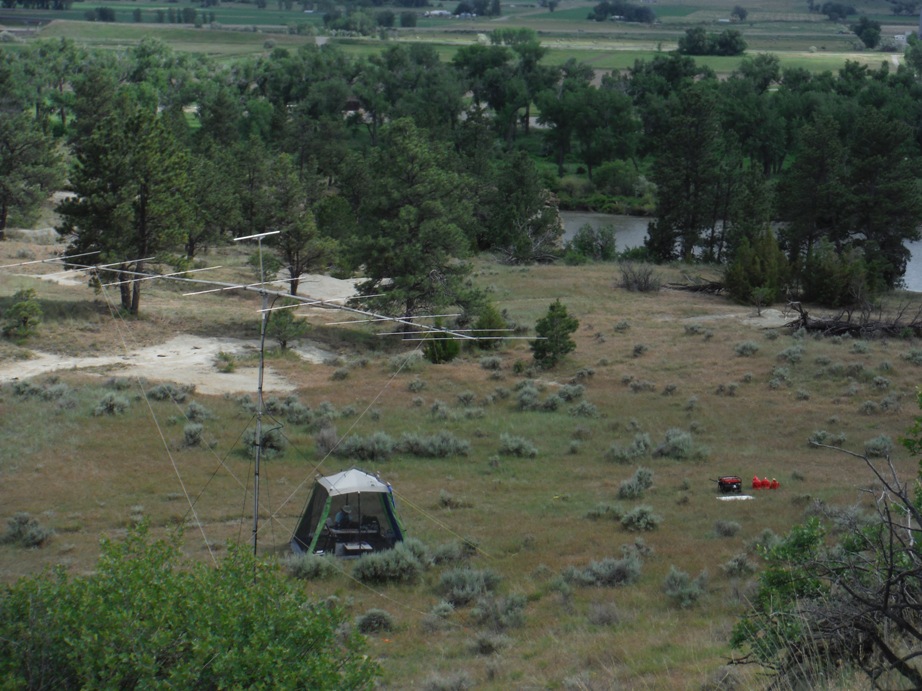
View of the Confluence
operating site from the higher ground
immediately to the northwest. The
Yellowstone River, 200' below the operating
posiion, is shown to the south.
SITE LOCATION
To qualify as a Confluence operation, parts
of the station must be in all four
grids. As you can see in the site map
below, the actual antenna mast was a couple
feet into DN66, the northwest guy anchor for
the mast was in DN56, the equipment and
operating tent was in DN65, and the
generator was on the "cattle path" in DN55.
Of course, the 6M8GJ elements hung over all
four grid squares wherever the beam was
pointed!
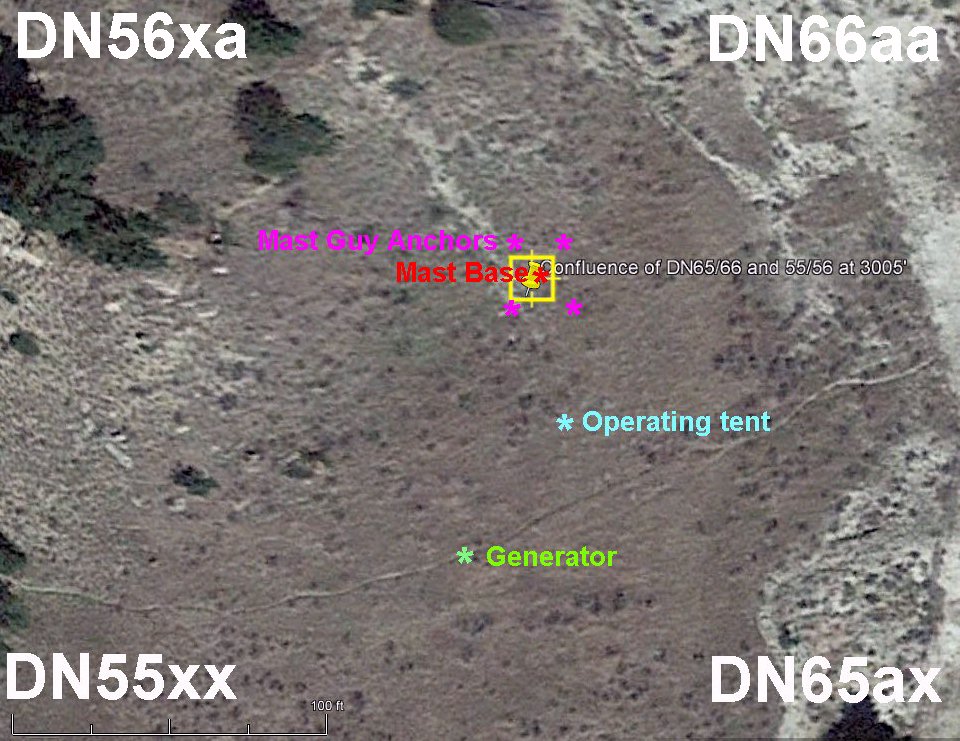
EQUIPMENT
I ran a single TE Systems 350w amplifier on
transmit. The antenna was my 6M8GJ yagi on a
24' high mast, fed with 75' of LMR-600 low
loss coax feedline. For receive, I
used a modified ARR preamplifier into an RTL
Dongle. 220 VAC was provided by a 4 kw
generator. I used 50' of heavy extension
cord to reach the operating tent. One of the
reasons I had bothered to take the big 6M8GJ
yagi was to try out the lightweight
hinged elevation mount I had built for
use on EME DXpeditions. As it turned out,
the lightweight version held up fine, and
actually helped with some of the closer
meteor scatter contacts!
Ready to raise 6M8GJ
- photo courtesy of KB7Q
RESULTS
Over 300 contacts were put in the log on 6m
using MSK144 and FT8. I was not able to
upload the WSJT-X files to LOTW, but
fortunately, all but a few of the contacts
were also logged in TRX-Manager, and that
was successfully uploaded to LOTW for all
four grids. If you need a QSL card, please
send me an SASE direct. If you want to
contribute to the gas fund, my PayPal
address is simply my email address as listed
on QRZ.com. Thanks for all the contacts!
CONCLUSION
We were diligent to clean up everything and
leave the site as we found it. We survived
without injury, although Gene barely avoided
stepping on a rattlesnake! The rancher was
pleased with our operation and financial
contribution for the use of his property,
and is receptive to discussions with other
conscientious and responsible hams who are
interested in gaining access to activate
this Confluence. His contact information is:
Kent Oblender, 3041 Bundy Road, Worden,
MT 59088-9604, Telephone: 406 967-3070
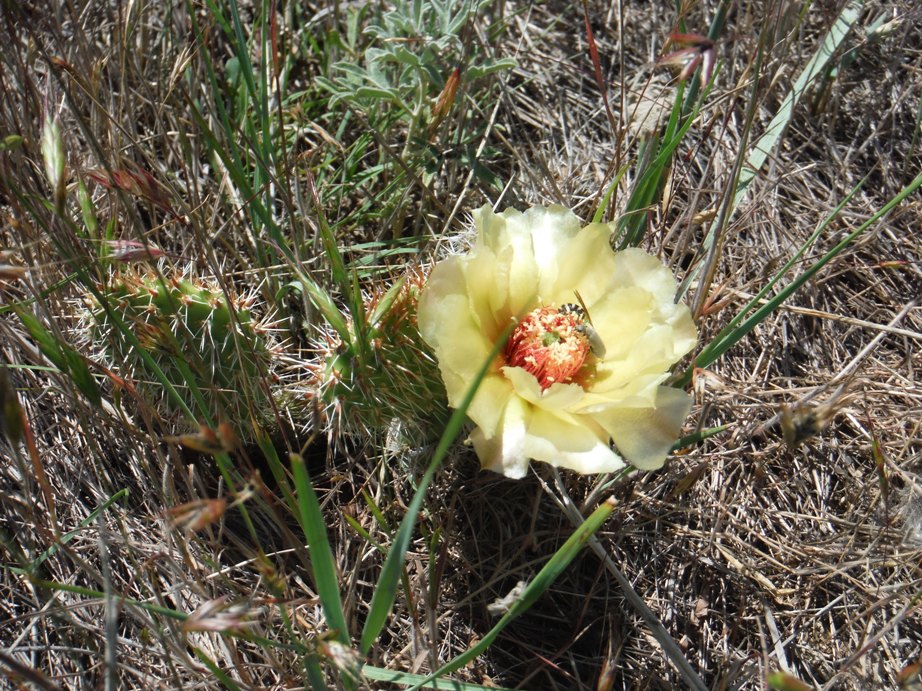 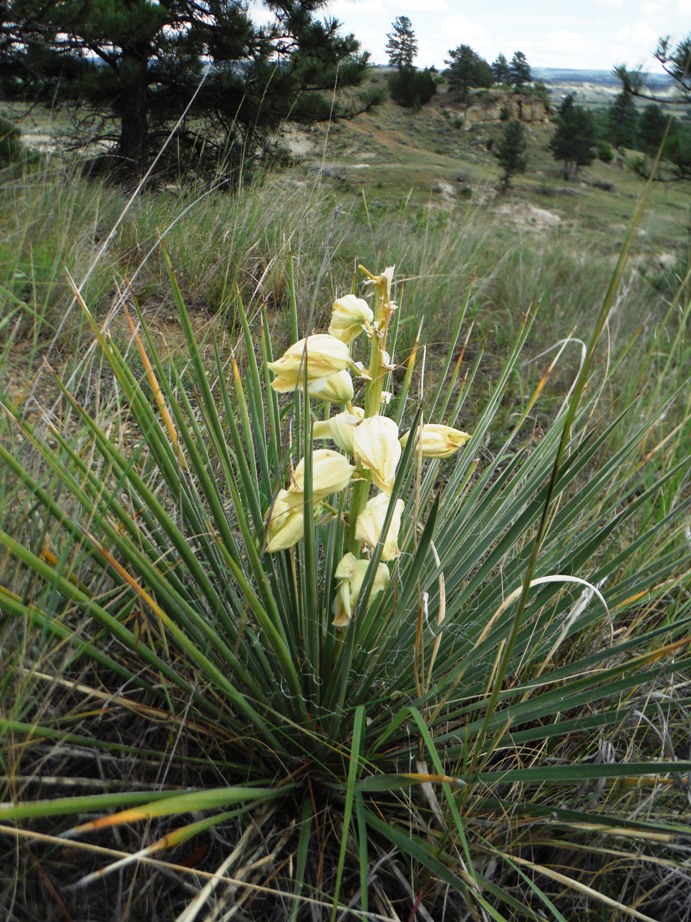
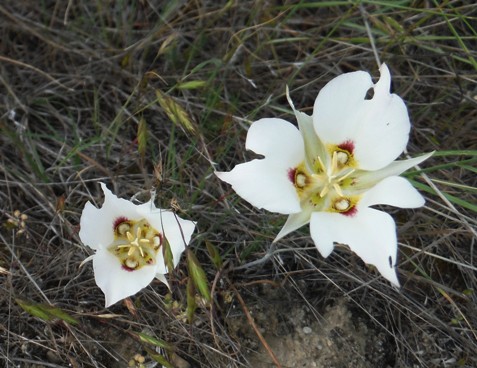 
|
|
July 25-26, 2020
DN25xu/DN35au Line
at 6203' on
Sula Peak |

Horizon profile from the antenna on Sula
Peak. The azimuth of the two peaks 70 miles
away in the Pintler Mountains
were used to calibrate the antenna aiming
circle at the bottom of the mast.
|
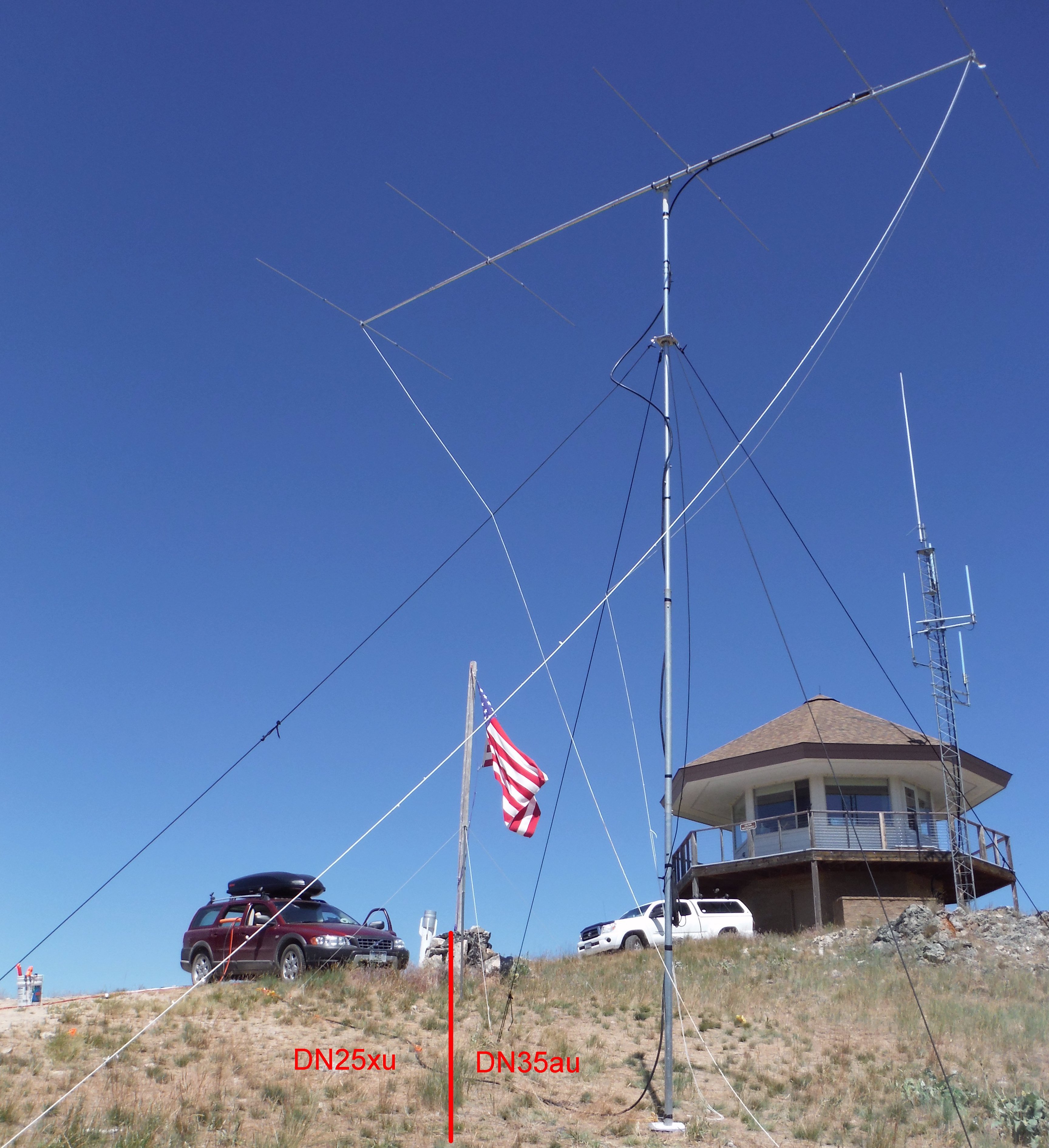
Photo of the Sula Peak antenna location and
operating position in the car, taken while
standing on the grid line
|
Station setup on July 26,
2020
|
  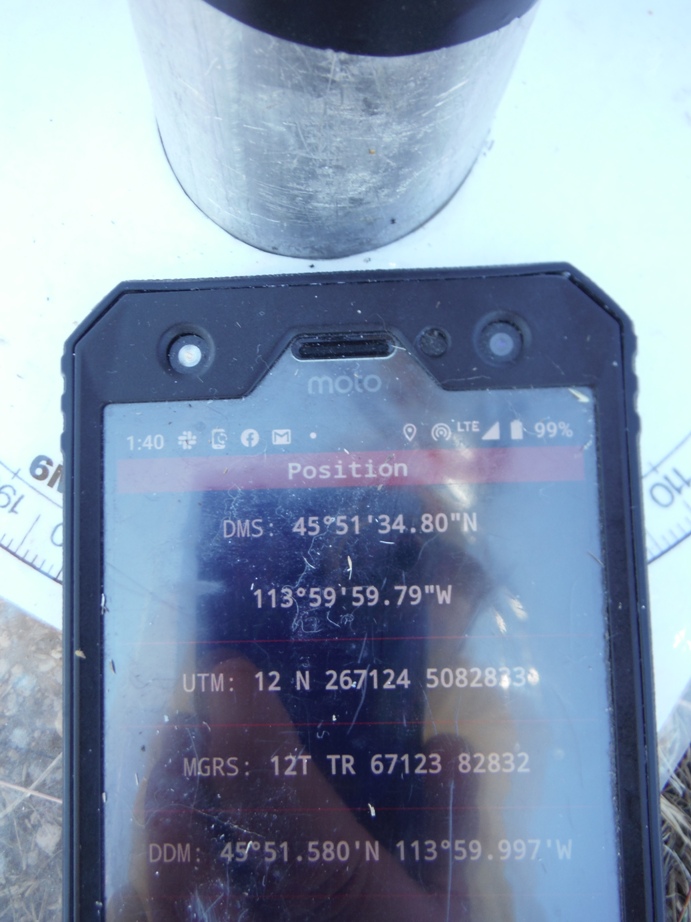
As you can see from the Google Earth photo on
the left, the longitude line of 114 degrees west
separating the two grids runs very close to the
summit of Sula Peak. The most level place for me
to park the car and operate was just west of the
grid line, so I set up the antenna just to the
east of the grid line. That way the station
spanned the grid line and FFMA contacts would
count for both grids. The generator was
set up 40' southwest of the car, so it was also
in DN25xu. In the center photo taken in the car
in front of my laptop computer, you can
see my longitude was slightly more than 114
degrees west, so I was operating in DN25xu.
The photo to the right shows the position of the
antenna mast, at slightly less than 114 degrees
west longitude, clearly in DN35au. The antenna
was an M2 6M5XHG on a 24' mast, fed with 50' of
LMR600UF coaxial cable. The transmitter was a
Yaesu FT-857 into a TE SYSTEMS solid state
amplifier providing 300 watts output. The
receiver was an ARR preamplifer ahead of an RTL
Dongle using SDR-Console connected to WSJT-X
Version 2.2.2 via a Virtual Audio Cable.
Computer was a DELL XPS 13 64 bit laptop.
|
Although
frightfully late in the season for Es out
here in Montana, I responded to pleas from
several W5's who said they were down to
their last bunch of grids and would
appreciate me activating the DN25/DN35 grid
line. Since the weather forecast indicated
an unusual absence of afternoon
thunderstorms for the weekend, I made a last
minute decision to pack up and head down
there Saturday morning.
I
was very pleasantly surprised to find good
Es on FT8 mode Saturday afternoon - I think
I had just missed a good opening by the time
I finally got on the air around 2100Z. I did
copy Cuba, and was copied in Florida, but
most of my contacts were single hop. Of
course the eastern stations complained of
QRM from all the East Coast and South
American stations filling up the band on
their end. Fortunately, I had an internet
connection via my cell phone hotspot so I
was able to QSY to clear frequencies for
them.
The
Es continued well into the evening, with
very spotty and short openings into various
locations in the upper midwest. I ended the
evening by working W0JW in IA at 0349Z
Sunday morning.
I
was up running MSK144 skeds at 1200Z Sunday,
although most of the stations who needed
DN25 and/or DN35 were outside meteor scatter
range. There were still quite a few good
random meteors Sunday morning, but most who
waited until Sunday afternoon to try their
hand at a meteor scatter contact were
disappointed. The lesson to be learned from
this is that if you want to work a 6m grid
DXpedition on Es, be prepared to hang in
there until late at night. And if you want
to work them on meteor scatter, be sure to
be at the rig no later than sunrise.
As
most of the other successful grid
DXpeditions, I ran FT8 contest mode the
entire time. The advantage of this is that
the contacts are quick and the grid squares
are always being displayed, so people can
see that you are in a rare grid. I did run
into problems with some stations who
apparently were not able to run WSJT-X
Contest Mode, and when the contacts stalled
on their end because of that, I had to move
on to the next caller. Sorry to have missed
contacts with those stations, but hopefully
by the next Es season, the word will have
gotten around on how to work a DXpedition to
a rare grid on FT8. We also may well have
some other mode by then called "DXpedition
mode" or "Grid mode" or something that will
work like the current WSJT-X Contest Mode
but will be more compatible with stations
using other types of programs. I know some
people simply stay away when the see someone
calling "CQ TEST" because they aren't
involved in any contest and figure the guy
must be a LID for using Contest Mode outside
a contest period. Maybe there will be
a better convention to call CQ by next
summer to indicate you are activating a rare
grid and not competing in a contest ("CQ
GRID", "CQ RARE", "CQ FFMA", "CQ DEDX" or
something).
Anyway,
I ended up uploading 119 contacts to LOTW
from this grid DXpedition. If you need a
physical QSL, please send me an SASE. Many
thanks to everyone who did show up to work
me and congratulations to you if you got a
new grid or two over the weekend!
I
have already had requests to activate some
grids next summer. I think after my two
DXpeditions to DN37tc, the demand for that
one has dropped down substantially. It has
been 5 years since I activated DN34gx above
Lemhi Pass (http://www.bigskyspaces.com/w7gj/DN34.htm),
and there seem to be a number of people
interested in that one again. I also would
like to activate Sula Peak again to be able
to give out DN25 and DN35 during an optimum
period for Es with a better chance of some
double hop.
|
|
|
This page last revised
on 14 August, 2020

|